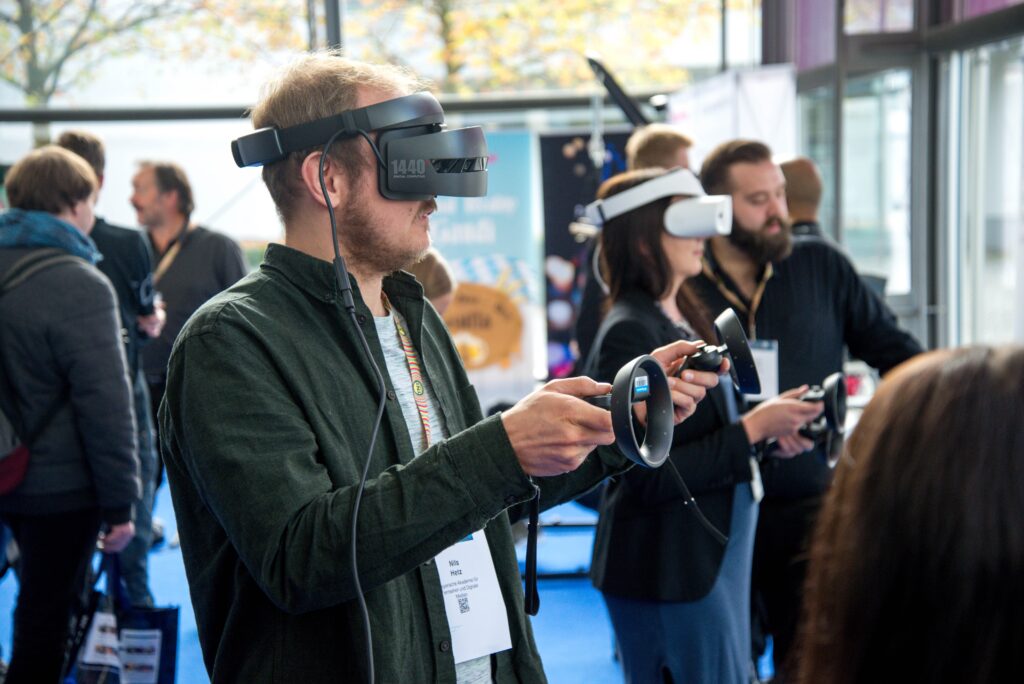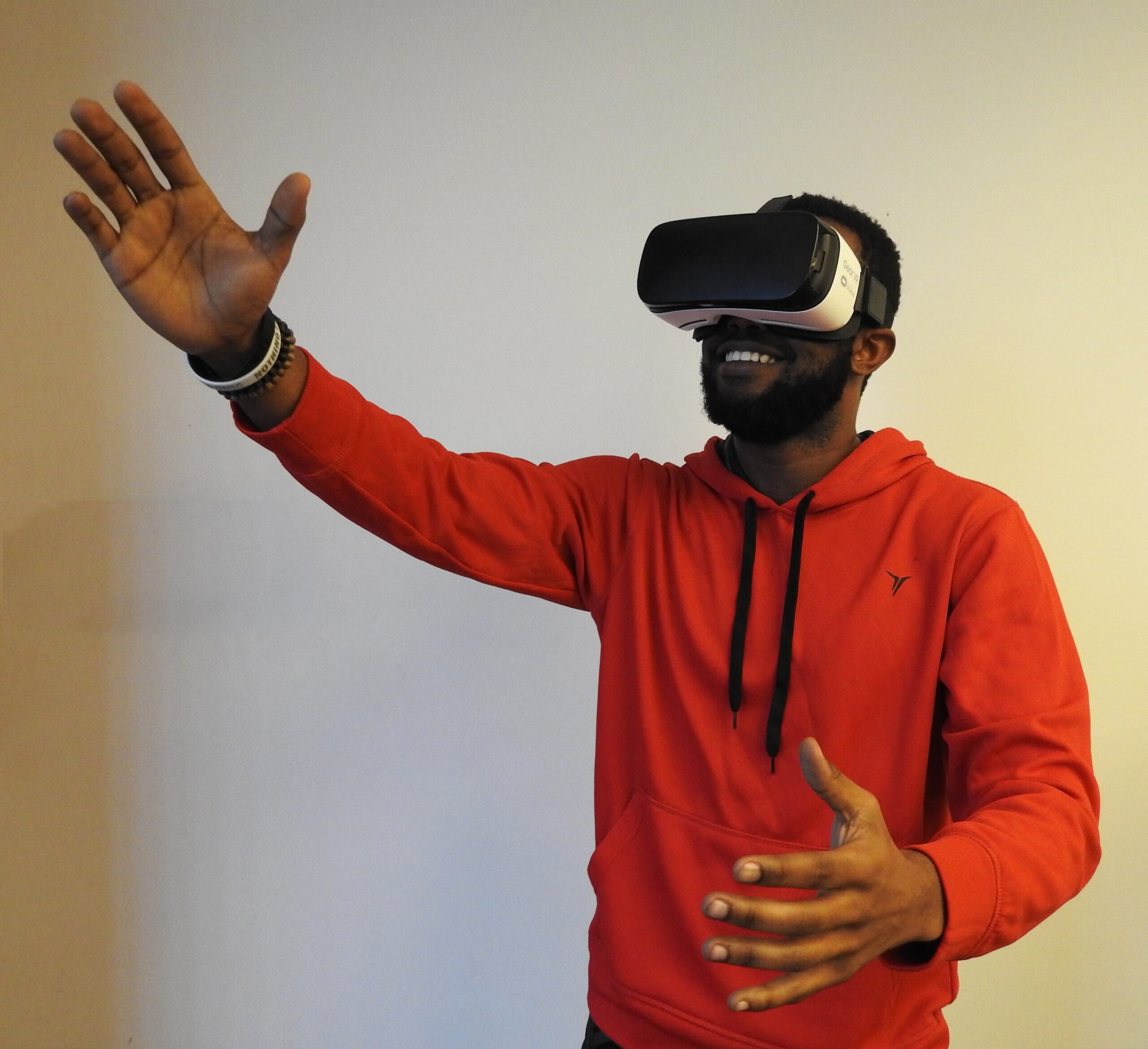The world of gaming has seen a remarkable transformation over the years, with technological advancements continually pushing the boundaries of what’s possible. Among these innovations, Augmented Reality (AR) has emerged as a game-changer, quite literally. In this blog, we’ll explore the fascinating connection between AR and gaming, the future possibilities it holds, and whether AR represents the next level of gaming.
How AR and Gaming are Connected

Augmented Reality (AR) and gaming share a symbiotic relationship that has reshaped the gaming landscape. AR seamlessly integrates digital elements into the real world, enhancing the player’s environment with interactive virtual content.
AR and gaming share a natural synergy, enhancing the player’s real-world surroundings with digital elements. This synergy manifests in various forms:
- Location-Based AR Games: Games like Pokémon GO took the world by storm by allowing players to explore the real world while encountering virtual creatures. This fusion of reality and gaming was a breakthrough.
- Immersive Experiences: AR headsets and mobile apps enable gamers to interact with virtual objects and characters in their physical environment, creating an immersive and interactive experience.
- Enhanced Storytelling: AR games offer innovative storytelling opportunities, blending the game’s narrative with the player’s surroundings, making every playthrough unique.
- Social Interaction: Multiplayer AR games encourage social interaction, as players can team up or compete with friends in shared augmented spaces.
AR and gaming are inextricably linked, with AR enhancing the gaming experience by adding layers of interactivity, immersion, and real-world integration. This connection continues to drive innovation and diversify gaming genres, shaping the future of interactive entertainment.
Future of AR and Gaming

The question of whether Augmented Reality (AR) represents the next level of gaming is a matter of perspective. AR undoubtedly introduces groundbreaking elements by merging virtual and physical worlds, enhancing immersion and interactivity. It encourages physical engagement, promotes social interaction, and expands gaming demographics.
However, traditional gaming, including Virtual Reality (VR), offers distinct experiences. While AR introduces exciting possibilities, such as location-based gameplay, it may not replace traditional gaming but rather complement it. AR is evolving and diversifying gaming, making it an essential and innovative component, but whether it is the ultimate “next level” depends on individual preferences and the evolving gaming landscape.
The future of AR in gaming is incredibly promising:
- Advanced Hardware: As AR hardware becomes more accessible and powerful, the gaming experience will reach new heights. AR glasses, in particular, hold immense potential for a seamless and immersive experience.
- Integration with VR: Combining AR and Virtual Reality (VR) could create entirely new gaming experiences, offering the best of both worlds—immersiveness and interaction with the real world.
- Diverse Genres: AR is not limited to a specific genre. From adventure and puzzle games to education and fitness, AR will continue to diversify gaming options.
Is AR the Next Level of Gaming?
AR has certainly opened up exciting possibilities, but whether it represents the “next level” depends on perspective:
- Enhanced Engagement: AR makes gaming more physically engaging and socially interactive, offering a unique dimension to the gaming experience.
- Real-World Integration: The integration of real-world elements adds depth and authenticity to games, blurring the lines between the virtual and physical.
- Innovation and Creativity: AR fosters innovation in game design, encouraging developers to think outside the box and explore new gameplay mechanics.
How AR is Changing the Gaming Landscape

Augmented Reality (AR) is reshaping the gaming landscape by seamlessly blending the virtual and physical worlds. Unlike traditional gaming, AR encourages physical activity, making games like Beat Saber a workout. Educational AR games make learning engaging and accessible to a broader audience. By overlaying digital content onto the real world, AR fosters deeper immersion and learning through play.
Moreover, AR gaming promotes social interaction, allowing players to collaborate or compete in shared augmented spaces. It democratizes gaming, bridging generational gaps and appealing to a diverse audience. AR’s ability to innovate gameplay, combine education with entertainment, and make gaming more physically interactive is transforming the industry’s future.
AR is disrupting traditional gaming in several ways:
- Physical Activity: AR games like Beat Saber encourage physical activity, promoting a healthier gaming lifestyle.
- Learning Through Play: Educational AR games make learning enjoyable and interactive, allowing players to acquire new knowledge while having fun.
- Accessibility: AR gaming can be accessible to a broader audience, including those who may not typically engage with traditional video games.
Conclusion
Augmented Reality is undeniably changing the gaming landscape, offering exciting new ways to play, interact, and explore. With advancements in hardware, diverse gaming genres, and the potential to merge AR with VR, it’s clear that AR is set to play a central role in the future of gaming. Whether it’s the next level of gaming or not, AR unquestionably represents a thrilling evolution in how we experience and enjoy games. Gamers and developers alike can look forward to a future filled with immersive, interactive, and innovative gaming experiences powered by AR technology.
FAQs
1. What exactly is Augmented Reality (AR) in gaming, and how does it differ from traditional video gaming?
In AR gaming, digital elements are superimposed onto the player’s real-world environment, creating an interactive and immersive experience. Unlike traditional video games, AR games blend the virtual and physical worlds, making the player’s surroundings an integral part of the gameplay.
2. What hardware is required to play AR games, and how accessible is AR gaming to the average gamer?
AR gaming can be enjoyed on various devices, including smartphones, tablets, and AR headsets. Entry-level AR gaming experiences are often accessible to anyone with a compatible smartphone, making it relatively accessible to a wide audience. More advanced AR gaming may require specialized hardware like AR glasses.
3. Can you provide examples of popular AR games and how they work?
Certainly! Popular AR games like Pokémon GO involve players exploring real-world locations to find and capture virtual creatures. Others, like Minecraft Earth, allow players to build and interact with virtual structures in their physical surroundings. These games use GPS, cameras, and sensors to merge the virtual and real worlds.
4. How is AR influencing game development, and what genres of games benefit the most from AR technology?
AR technology is inspiring innovation in game design across various genres. While location-based games like Pokémon GO are well-known, AR has also enriched genres like puzzle-solving, education, fitness, and social interaction. Developers are exploring new gameplay mechanics and storytelling techniques, thanks to AR’s unique capabilities.
5. What does the future hold for AR in gaming, and what are some potential challenges or limitations of AR gaming?
The future of AR gaming looks promising, with advancements in AR hardware, increased integration with Virtual Reality (VR), and a broader range of gaming experiences. Challenges include ensuring player safety during outdoor AR gameplay and addressing privacy concerns associated with real-world data usage. As technology evolves, these challenges will likely be addressed to further enhance the AR gaming experience.

